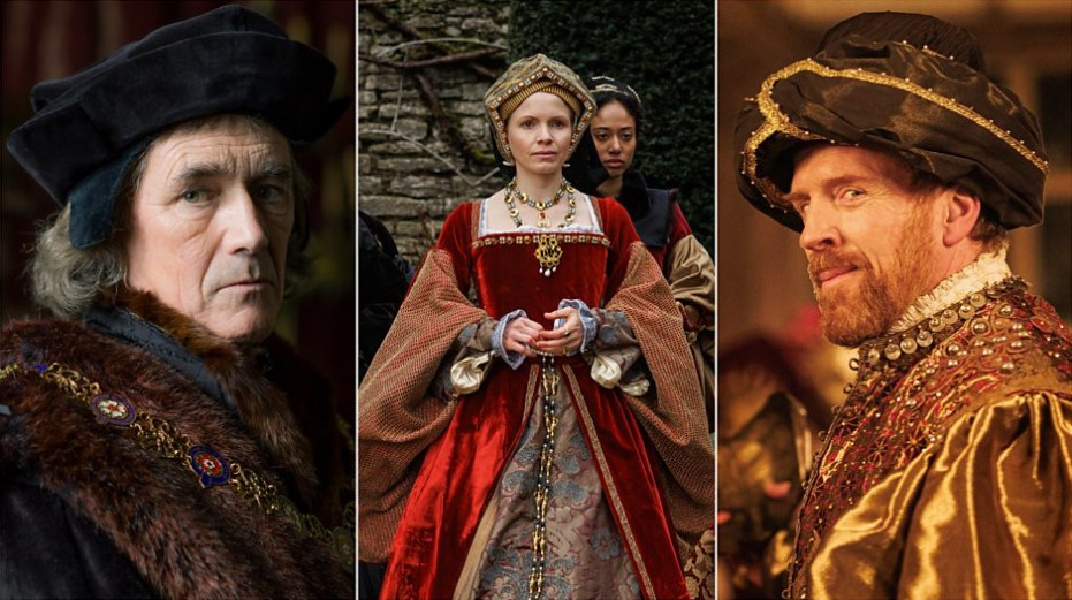– Back at Court with a Cranky King
and The Rebellion –
by Lady Trader | Fan Fun With Damian Lewis | April 11, 2025
Welcome back to Court and to episode 3 of “Wolf Hall: The Mirror and the Light.”
This week’s post will be like my last two since it seems my useless Tudor knowledge of Fun Facts has been quite popular.

A good portion of this episode had to do with the rebellion in the North. That rebellion was called the Pilgrimage of Grace, which began in October 1536. And although the break from the Catholic Church was a main grievance, there were many other reasons as well. There was also a long-standing distrust in the North of the Tudor monarchs, starting with Henry VII. Henry Tudor was seen by many as an usurper when he beat Richard III at the Battle of Bosworth in 1485. Henry Tudor was a Lancastrian, while Richard was the last King of the House of York; the North were never fans of the Tudors. And as you can see from Henry’s distain for the Northerners, the feeling was mutual. It also did not help that in the 27 years Henry had reigned, not once had he visited the North on progress. (He eventually travels to York in 1541 with his fifth wife, Catherine Howard.)

As Cromwell and Henry dissolved the monasteries, this not only deprived the population of places to worship, but the churches and monasteries were places where people would go for food and shelter. A poor harvest of 1536 caused a food shortage, and the communities no longer had the abbeys to help supplement their needs.
Take away people’s food and their religion and there are going to be issues, to say the least.
Northerners believed that with Anne Boleyn set aside, the King would return to the Catholic religion and back to the Pope. They were very willing to have Henry be their King but also wanted the Pope as the spiritual leader. Henry was not having that.
When Henry did not restore Catholicism, Northerners began to blame Cromwell. They believed it was Cromwell who was the one seizing the land, jewels, and gold from the monasteries and lining his pockets. They saw him as a devil who used sorcery to seduce the King to make these changes. (Anne was also accused of using sorcery to seduce Henry – I think this doesn’t say much about how easily they feel Henry can be lead.)
Henry sends the Duke of Norfolk, Thomas Howard and the Duke of Suffolk, Charles Brandon, to the North to suppress the rebellion. (Just a note: Charles Brandon was a very close friend and advisor to Henry. They were friends from childhood and fought in France twice together and Brandon was married to Henry’s sister Mary. I don’t understand why Brandon plays such a non-existent role in this series.)
Along with brutally containing the rebellion, Norfolk promises the rebel leaders, including Robert Aske, all the things Cromwell mentions – a general pardon, make Mary legitimate, etc. However, it was all a rouse. Aske traveled to London to meet with Henry during the Christmas holiday. On his way back North, Aske was arrested and later hung in chains as a traitor at York.
Henry believes the Poles and Courtenays are behind the rebellion. He is not entirely wrong; they did give support to the rebels and an embroidered tunic bearing the Five Wounds of Christ, the Pilgrimage of Grace symbol, was found in Margaret Poles’ home. This evidence was used to find her guilty of treason. In 1541 Pole was killed in a very botched execution in which it took eleven strokes of the axe for the executioner to remove her head.
I often wonder why Henry had such contempt for the people of the North, and York in particular. His mother was Elizabeth of York who he loved dearly. Also, he tried to emulate his grandfather, Edward IV who was the head of the House of York. He had Yorkists blood running through his veins, and in many ways behaved more like a Plantagenet than a Tudor.

We see at the Privy Council just how much the nobles distrust Cromwell…
Read the rest of the original article at Fan Fun With Damian Lewis





